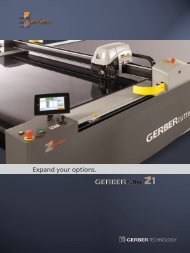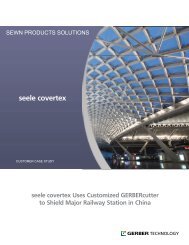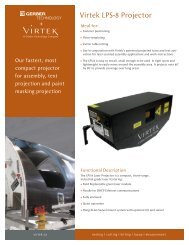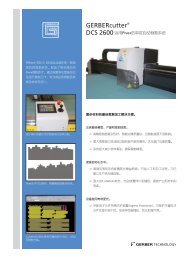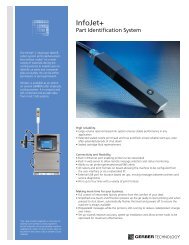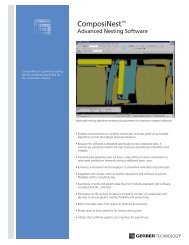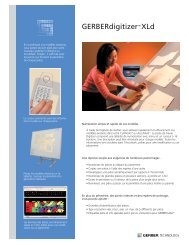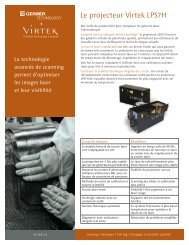SC OD Y - Gerber Technology
SC OD Y - Gerber Technology
SC OD Y - Gerber Technology
You also want an ePaper? Increase the reach of your titles
YUMPU automatically turns print PDFs into web optimized ePapers that Google loves.
13<br />
16<br />
<strong>SC</strong><strong>OD</strong>Y<br />
A company that<br />
started producing<br />
custom-order sports<br />
clothing in 1997<br />
is investing in new<br />
machinery to create<br />
a more efficient<br />
and cost-effective<br />
production process.<br />
Dawn Adams reports.<br />
+<br />
efficient & effective<br />
It was a total<br />
change, we had<br />
to alter the way<br />
we did business<br />
from one end to<br />
the other<br />
Bernard Schreiber<br />
Scody managing director<br />
A new <strong>Gerber</strong> Cut System is<br />
empowering a sportswear<br />
supplier to fulfil custom-made<br />
orders within just two weeks.<br />
Scody managing director Bernard<br />
Schreiber explains that the<br />
company started looking for<br />
ways to better automate its<br />
production processes around<br />
18 months ago. “Traditionally, a<br />
custom clothing business would<br />
cut fabric and then print it,” he<br />
says. “We wanted to change that<br />
process, to print before we cut.<br />
I literally went to equipment<br />
manufacturers with bolts of<br />
fabric on my shoulder to ask for<br />
help.”<br />
Unable to find exactly what he<br />
sought in Australia, Schreiber<br />
was urged by <strong>Gerber</strong>’s Australian<br />
representative, Bill Ramsay, to<br />
contact his US counterparts. “Bill<br />
suggested we talk to <strong>Gerber</strong> in<br />
the US,” he says. An eight-month<br />
collaborative process followed<br />
that involved intensive research<br />
and development to create a<br />
pathway for Schreiber to reach<br />
the goal he had earlier set out to<br />
achieve, to print fabric before it<br />
was cut.<br />
“<strong>Gerber</strong> put together various<br />
technologies for us and drew<br />
them from different industries,”<br />
Schreiber says. Inputs for the<br />
new <strong>Gerber</strong> Cut System came<br />
from the US, Denmark and<br />
Belgium, but before it could<br />
be installed, Schreiber says<br />
the processes in-house had<br />
to be changed. “It was a total<br />
change; we had to alter the way<br />
we did business from one end<br />
to the other,” he says. Rather<br />
than have the various steps of<br />
production take place more<br />
randomly around the factory,<br />
Schreiber established a clear<br />
linear system. “Each job with<br />
this system takes places in a<br />
sequential process, proceeding<br />
in a regimented way,” he says.<br />
“The job starts at one end of the<br />
factory and comes out the other,<br />
so you can measure how long<br />
each process takes. The beautiful<br />
thing about equipment is that it<br />
is predictable.”<br />
The <strong>Gerber</strong> Cut System has three<br />
components: an optical scanner<br />
and its required software, a<br />
high-speed conveyorised cutter,<br />
which had previously been used<br />
in the furniture and leather and<br />
carpet industry, and a feeder. “A<br />
traditional garment manufacturer<br />
relies on laying out fabric in<br />
multiple layers and cutting them<br />
together, but we use single ply,<br />
so we need to feed the fabric<br />
faster to get the same output,”<br />
he says. “We can also use it as<br />
a normal cutter for unprinted<br />
fabric with a CAD system.”<br />
Schreiber claims that this<br />
system is the first of its kind<br />
in the world. “<strong>Gerber</strong> already<br />
had knowledge about optical<br />
scanning and needed to create<br />
new programming for it to<br />
be suitable for the clothing<br />
industry,” Schreiber says.<br />
Involving an investment<br />
from both <strong>Gerber</strong> and Scody<br />
to develop the new system,<br />
Schreiber says his firm’s<br />
contribution was assisted by<br />
a grant through the Strategic<br />
Investment Program. “The SIP<br />
funding helped me make the<br />
decision,” he says. “Without<br />
access to those funds, it would<br />
have been a bigger decision.<br />
With something new, you can’t<br />
quantify what you get until it’s<br />
finished.”<br />
+<br />
<strong>Gerber</strong> put<br />
together various<br />
technologies for<br />
us and drew them<br />
from different<br />
industries<br />
Bernard Schreiber<br />
Scody managing director<br />
17
18<br />
Stretchtex<br />
has become<br />
a specialist<br />
in developing<br />
technical fabrics<br />
in Australia.<br />
Examples of<br />
these efforts in<br />
research and<br />
development<br />
include Sorbtek,<br />
a compression<br />
fabric with<br />
permanent<br />
moisture<br />
management<br />
properties. Also<br />
available is a<br />
liquid titanium<br />
fabric promoted<br />
as ideal for<br />
performance<br />
sportswear.<br />
+The optical<br />
scanning<br />
system<br />
sends the<br />
instructions<br />
to the cutter<br />
Bernard Schreiber<br />
Scody managing director<br />
<strong>SC</strong><strong>OD</strong>Y<br />
efficient & effective<br />
Measurable outcomes<br />
But he is convinced that the expenditure<br />
was very worthwhile, as significant<br />
measurable outcomes have been achieved.<br />
“In a traditional operation, there is a lot of<br />
bundling and rebundling of fabric pieces,”<br />
he says. “We bundle once, which saves a<br />
lot of labour. This system also increases the<br />
accuracy of the print and cutting process<br />
and increases our capacity significantly. We<br />
expect to be able to double our volume of<br />
garments through our factory with the same<br />
number of people employed.”<br />
This system also differs significantly from<br />
those that operate with a traditional cutter<br />
using a CAD system to relay instructions.<br />
“The optical scanning system sends the<br />
instructions to the cutter,” Schreiber says.<br />
He claims that previous methods meant<br />
it was difficult to cut accurately if fabric<br />
printing was completed first. However, the<br />
optical scanner enables accurate cutting by<br />
absorbing the detailed printed information<br />
on a fabric. “It can cut a cycling jersey,<br />
triathlon vest and running top perfectly even<br />
when they are all set out next to each other,”<br />
he says.<br />
And the system is set up to enable growth<br />
within the company. “We now have a<br />
production cell that can handle our current<br />
volume, with a matched printer and heat<br />
press with cutting system,” he says. “We do<br />
one shift a day and can do more or replicate<br />
the system by putting in another line if we<br />
want. There is lots of capacity.”<br />
A team of two local Australian <strong>Gerber</strong><br />
representatives and another from the US<br />
company spent three weeks full-time at<br />
Scody setting up the new system and training<br />
staff about its operation.<br />
Schreiber is now making plans to develop the<br />
business, including considering producing<br />
garments for additional sports such as netball<br />
and basketball to complement its current<br />
custom-made cycling and triathlon offering.<br />
“We’ve found cycling and triathlon are at<br />
the leading edge of garment technology,”<br />
he says. “The information we’ve learnt from<br />
these sports translates well into other areas.”<br />
While convinced of potential in certain<br />
markets, he is also clear about categories that<br />
the company has no intention of entering,<br />
saying that the rugby codes are already well<br />
catered for and that schoolwear requirements<br />
are different because they require more<br />
robust fabrics, rather than the technical ones<br />
that Scody specialises in. “Our focus is on<br />
technical fabrics at a higher quality end,” he<br />
says.<br />
High-tech fabrics<br />
Schreiber describes the fact that new<br />
developments are occurring all the time in<br />
technical fabrics as a ‘luxury’, enabling the<br />
business to produce innovative offerings<br />
regularly. “These fabrics are changing all<br />
the time; there is always something new, so<br />
we focus on sourcing,” he says. And he also<br />
points to a dynamic sector where advances<br />
are often made in construction techniques<br />
and patterns.<br />
Technical fabrics selected by the firm have,<br />
for example, anti-microbial properties that<br />
do not encourage the growth of bacteria<br />
from perspiration, or moisture management<br />
properties to keep the fabric dry and to<br />
stop chafing for a better performance.<br />
Maximum sun protection is achieved through<br />
a combination of the design of the garment<br />
and the fabric chosen.<br />
The use of local suppliers of technical fabrics<br />
like Stretchtex is complemented by sourcing<br />
from around the globe.<br />
While its custom-made selection produced<br />
in Australia makes up the largest part of its<br />
business, the firm also supplies garments for<br />
cycling and triathlon that are made in China<br />
and supplied to Rebel Sport, and it sponsors<br />
elite athletes and sporting events.<br />
Schreiber notes that <strong>Gerber</strong> is interested in<br />
one day expanding its sales into international<br />
areas, and the new <strong>Gerber</strong> Cut System will<br />
make its products more competitive in the<br />
marketplace.<br />
“Inside a year, we hope to have all orders<br />
completed within two weeks,” he says. “That<br />
will be harder for others to compete with.<br />
And we’re in the process of introducing an<br />
ability to re-order in garment quantities<br />
of ‘one’; which is the result of our new<br />
equipment,” he says.<br />
ThIS ARTIClE oRIGInAlly APPEARED In ATF - AUSTRAlASIAn TExTIlES AnD FAShIon mAGAzInE SEPTEmBER/oCToBER 2010 EDITIon<br />
19


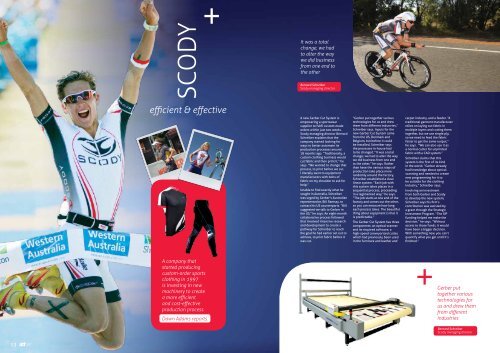
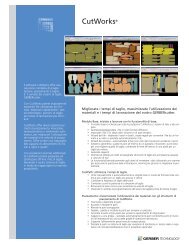
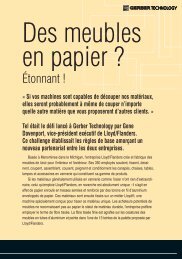
![Download Fast Facts [PDF] - Gerber Technology](https://img.yumpu.com/8694541/1/190x245/download-fast-facts-pdf-gerber-technology.jpg?quality=85)
![Descargar información de la empresa [PDF] - Gerber Technology](https://img.yumpu.com/8670734/1/190x245/descargar-informacian-de-la-empresa-pdf-gerber-technology.jpg?quality=85)
